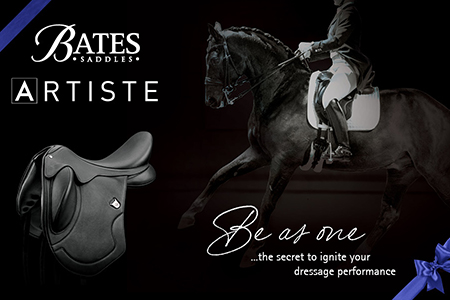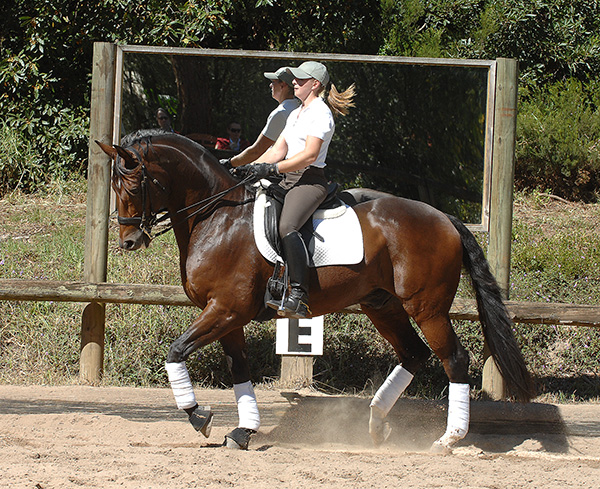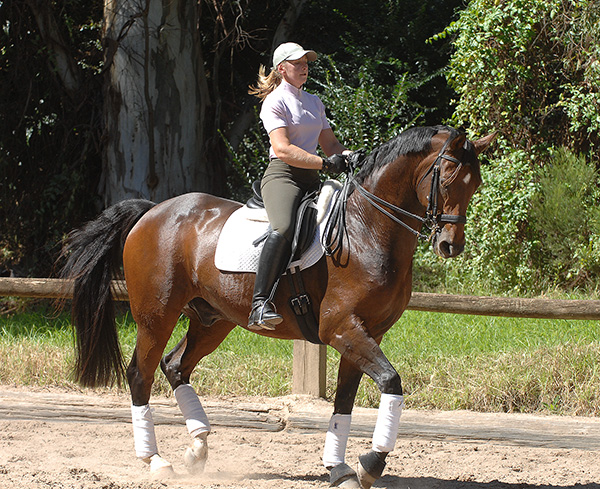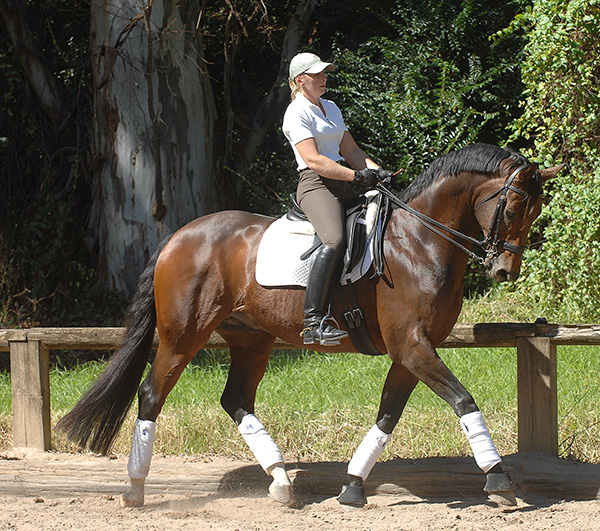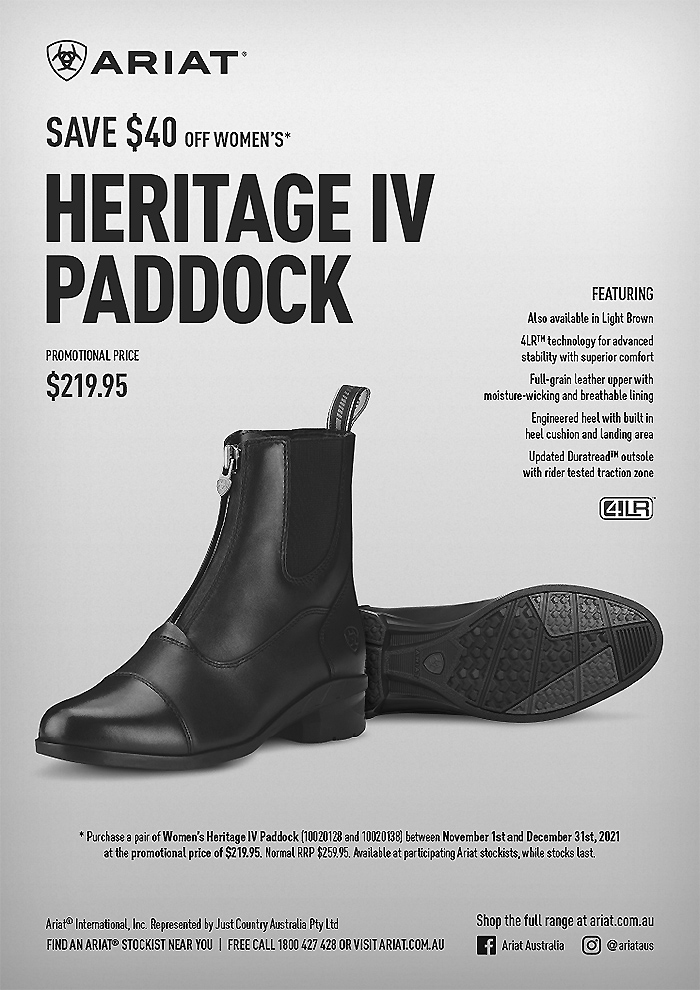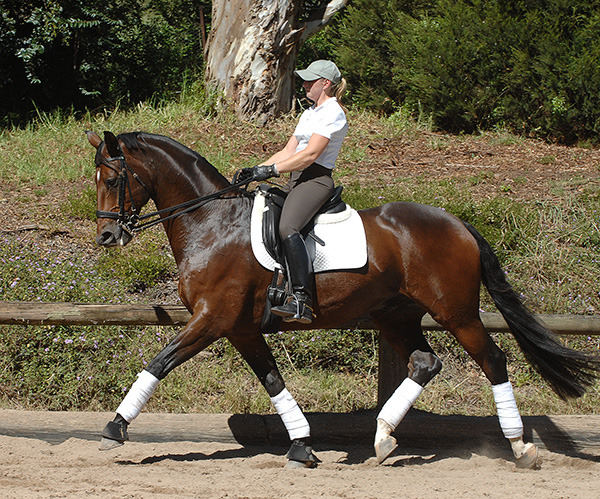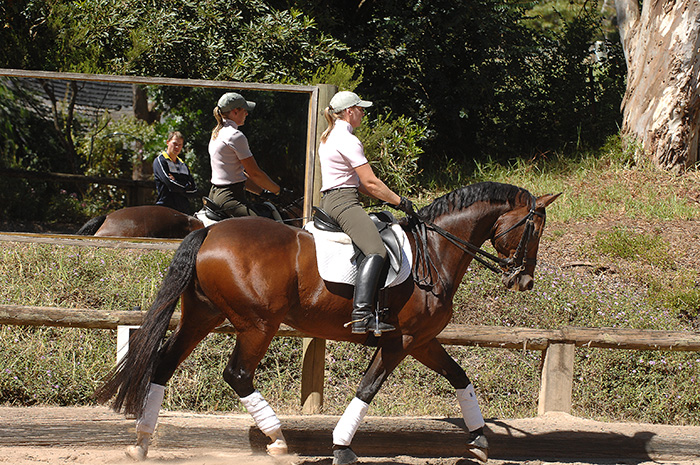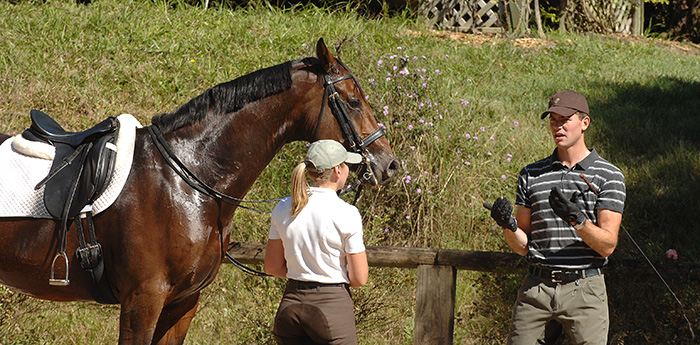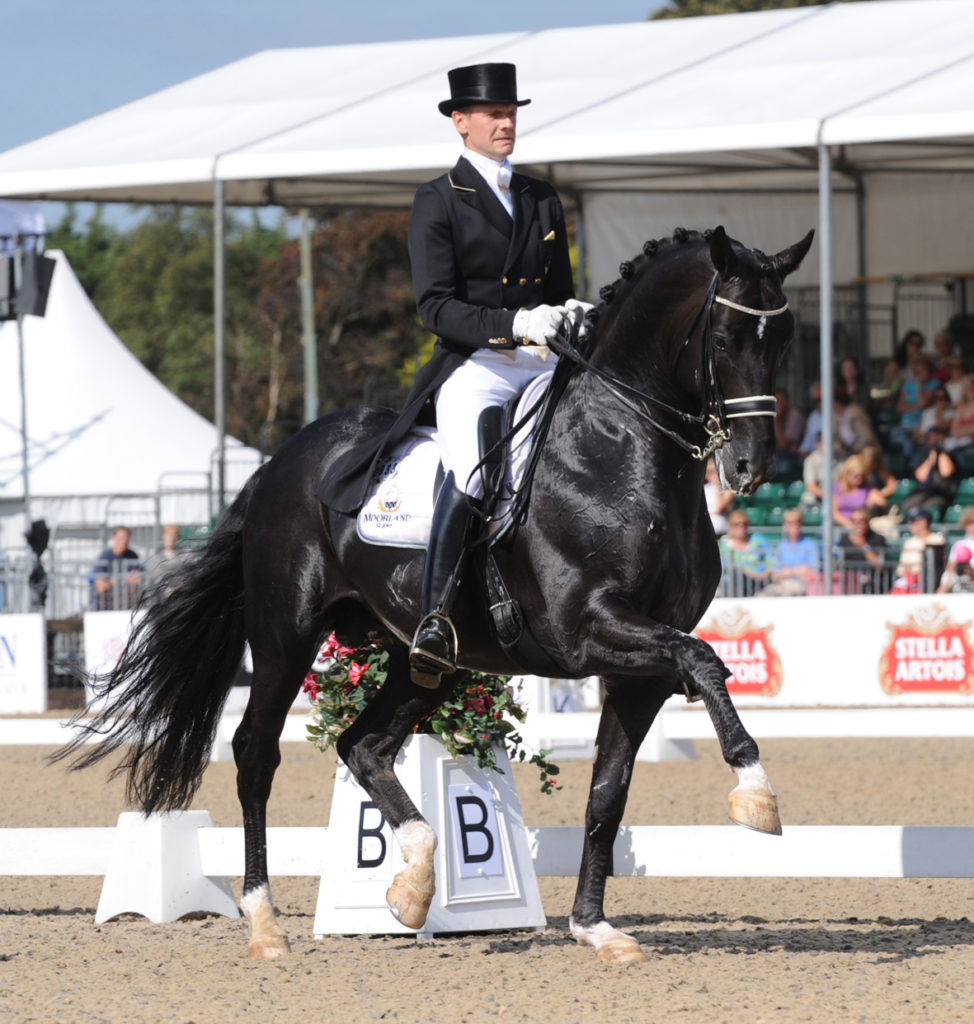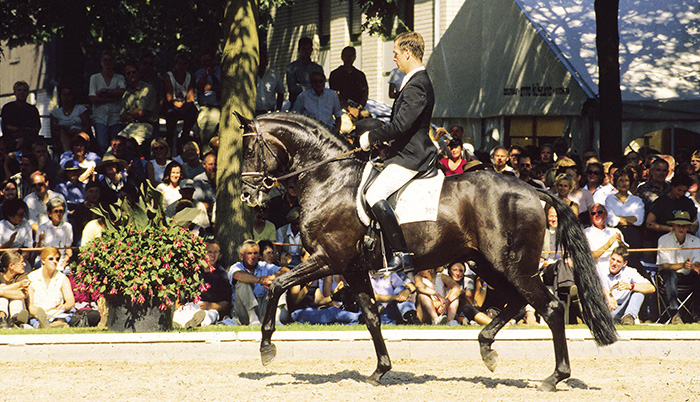 Story by Chris Hector and photos by Roz Neave
Story by Chris Hector and photos by Roz Neave
Stefan Wolff works on that essential quality, Connection, and shows us good connection comes from riding the horse from behind, into the hand.
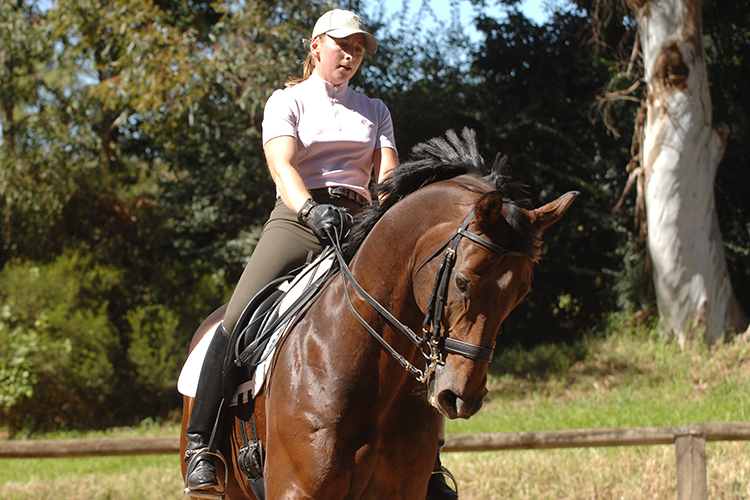
Stefan is working with FEI rider, Linda Foster and Mauritius, to get the horse more through, more connected and yet again we discover how simple yet subtle this business of riding is: “Be careful, the hindlegs get quicker, but the impulsion is not going through the whole body. Get the hindlegs more connected to the front. You don’t have to worry about the activity, the activity is sufficient, it just has to connect to the body of the horse. Not just for two steps, there must be a constant connection, and make sure when you bring him back, you don’t lose the flow of the movement. You can only bring him back as much as you have him from behind. Don’t bring him back and slow the movement. Now bring him back, but within the forward movement…”
“Think a little bit more forward when you collect. Keep riding, keep riding, get the collection in forward, collect him and go, collect him and go. Shorten the reins – light hands – and make him more active off the leg, you need a better acceptance of the leg. Don’t interrupt the movement when you collect him. Don’t get passive in your leg, you are shortening the stride too much in the collection. Be a little more demanding from behind – now light…”
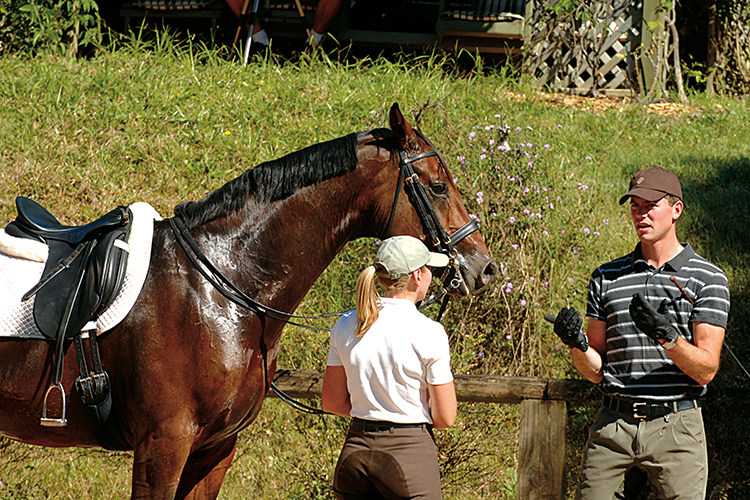
And the strange environment was no excuse: “Make sure you are not as defensive as your horse. Say ‘ok you are a little scared, but I am here to motivate you to go’. Collection does not mean less impulsion, just that you transfer this impulsion.”
And there was always a correct time for the correction: “You start reacting when it is too late. You have to act and let him re-act. Be earlier than him.”
next shoulder in
The next exercise was shoulder in: “Not too much angle – and then you get better bend. Both your legs have to move the horse towards the bit, even though the horse goes sideways.
In the half pass, the legs work primarily to the bit, not sideways. Within the sideways movement the horse needs to be connected with the reins… In the half pass, down the hand, and close your legs, both legs straight towards the bit.”
“Don’t attack with the driving aids. Worry more about a compact horse, use the leg to bring the back up. When would you bring him back? You can only bring him back when he is connected, otherwise you just hollow the back. Use your leg to make the whole thing more confident.”
“The driving that you are doing to get out of the half halt, is the driving you should be doing to get into the half halt. When you hesitate with your body and legs when you get in half halt, you lose everything. Don’t do more when you get out of the half halts than you do when you get into the half halts – rather the other way around.”
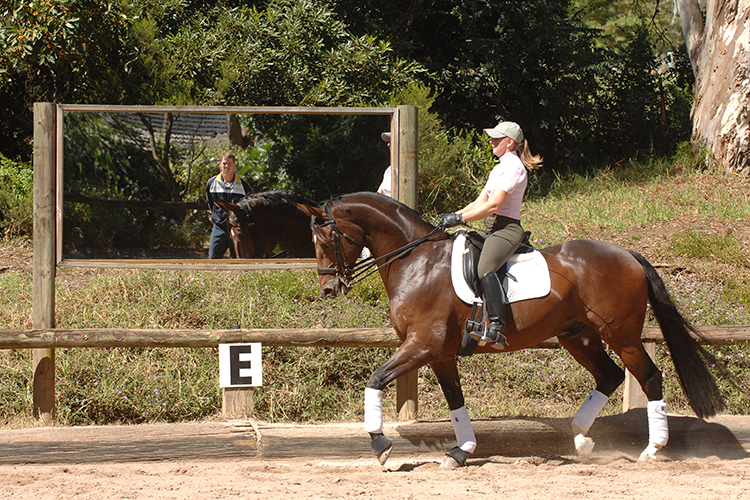
And all the time, Stefan wants the horse softer, more accepting of the aid:
“Soften the neck, the position is good but the suppleness is not there. Once he is in rhythm don’t chase him out, just let him carry you forward. And now in the extended trot – keep the collection.”
Stefan’s take on the lesson with Linda and Mauritius:
“The horse has nice gaits, good ground covering quality. He has a little the tendency to come back, bring the neck up and hollow his back, which makes it pretty hard for the rider to keep constant impulsion in the horse. Especially when you come to the moment where she is about to collect the horse, the horse tends to come back and lose the impulsion. It’s a little bit hard to get him working from behind, so you can convert impulsion into collection. It is important in that moment that Linda makes very sure that she keeps the impulsion from behind alive, or steady, when she brings the horse back into collection.”
You worked through that today?
“No we didn’t work through it. I think the first day you work with a rider is always there to open up problems and to start working on the major problems. Linda is here for at least three days, so we will continue to work on that. She got it – especially on the straight lines – she had a couple of nice moments. Of course in the half passes it is always harder to get the big rhythm, so we’ll keep working on that problem.”
You were trying to get a more even connection, even in the lateral work?
“Absolutely, the important thing in the lateral work is that you keep the basics correct, which means in the half passes we are not only thinking about driving the horse sideways – the sideways-moving horse must keep the straight work into the rein.”
more on lateral work next
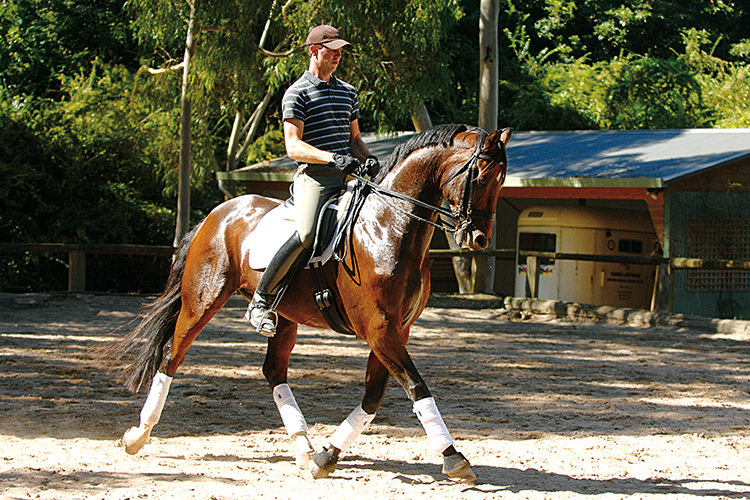
If you are losing that, should you stop the lateral movement and go straight forward?
“You can try to refresh the impulsion and the straightness within the half pass, but if you don’t get a result – with this horse it is not so easy to get the impulsion back, then you can use a couple of forward steps on a straight line, then enter the half pass again, so you end up doing three strides half pass, three strides straight, constant change between straight steps and half pass steps, which can make it easier to get back the big rhythm.
The second day, Stefan was still focussed on connection: “We had the problem again of the connection. The horse has the tendency to hollow the back and therefore it is difficult – especially in the lateral work – to keep the big rhythm, because then it is harder for the horse to keep the back up and keep the rhythm. So we really did the same as yesterday – to have impulsion – but to make sure this impulsion is not disappearing somewhere but is connecting into the bit – so that there is the possibility to half halt the horse.”
It was interesting, Linda was doing extended trot and you were saying ‘keep the collection’…
“Extension is not chasing forward, in extension you keep a big part of collection in the horse. A proper extension depends on collection, so that the horse does not get out of balance. That’s the important thing that the horse stays in a total, proper balance and rhythm, and just lengthens the steps.”
The other concept is to separate your hands from your driving aids?
“That was especially for this rider because when she half halts she always slows the rhythm and the speed down. The hand in this case interferes with the natural movement and makes it slower, so we always have the problem that the horse does not swing in the half halt and keep the rhythm and have the higher cadence – it actually loses a bit of movement. So this was just a way that I tried to explain to Linda that the rein in the half halt is not to interfere with the movement – the movement should stay free and independent in the half halt, we are just asking for a higher level of collection.”
You were saying to Linda that the amount of forward you are giving at the end of the half halt, should be the amount of forward that you give going into the half halt…
“A clear half halt is ridden in such a way that the leg and the seat are driving the horse forward into a stronger contact and then the hand just restrains, and that is the aid that brings the horse in the higher collection. With Linda, what was missing was that the rider first drove the horse into a little more contact – and then the hand came back, so it was not possible to have a proper half halt – that’s why I was trying to get Linda to push the horse more into the half halt…”
Breeding a Dressage Star in Australia? Go to www.ihb.com.au and select from the range of top European Bloodlines – including the lines of the 2021 Rankings Leaders – Like Totilas and Sandro Hit
This article first appeared in THM September 2008.

